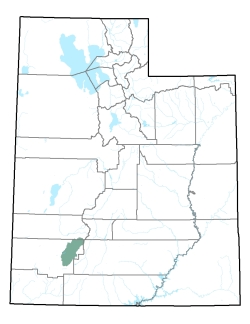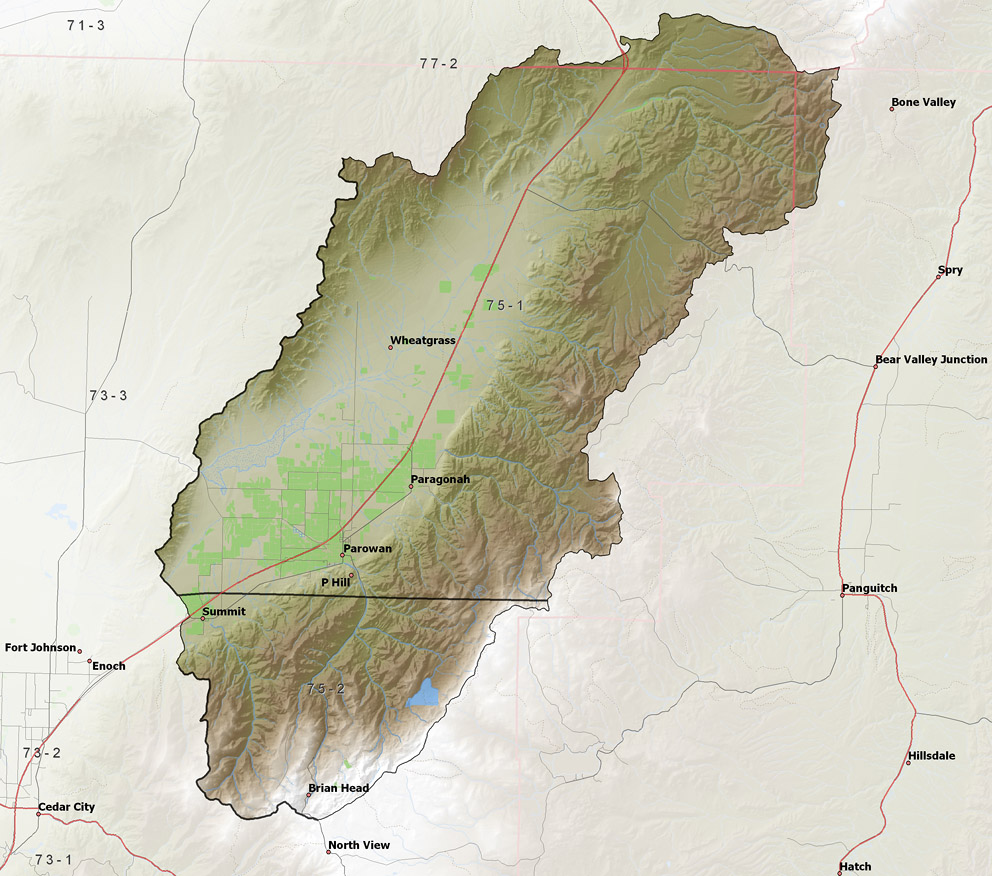AREA 75 - PAROWAN VALLEYUpdated: April 17, 2011 |
|
|
MANAGEMENT Water rights in this area were compiled into three proposed determination books in 1967; a pre-trial order was issued in 1970. There is a state-administered water distribution system in this area; the Parowan Valley Distribution System, which oversees the distribution of ground water. The system is under the jurisdiction of the Parowan Valley Commissioner. Click here to see statistics for this area. SOURCES Surface and Ground Water - All waters of the basin are considered to be fully appropriated. New diversions and uses must be accomplished by change applications based on valid existing water rights. Fixed-time projects must be accomplished by temporary change applications on valid existing water rights, which require annual renewal. The basin is divided into two subareas. The boundary is generally delineated by the southern boundary line of T32S. No change applications between subareas are allowed. Change applications proposing a change from surface to underground sources or vice versa will be critically reviewed to assure hydrologic connection, that there are no enlargements of the underlying right(s), and that there will be no impairments of other rights. Water rights for the mountain headwaters and Brian Head resort area are generally restricted to change applications on existing "first priority" rights already on Parowan/Main Creek or Summit Creek. Applications proposing transfers of rights between the Parowan/Main Creek and Summit Creek drainages are not approved. GENERAL Applications are advertised in the Spectrum/Daily News. The general irrigation diversion duty for this area, which the State Engineer uses for evaluation purposes, is 4.0 acre- feet per acre per year. The consumptive use requirement is determined from the publication Consumptive Use of Irrigated Crops in Utah, Research Report 145, Utah State University, 1994, unless the applicant submits other data for consideration. This area is administered by the Southwest Regional Office in Cedar City. Other Requirements The Water Right applicant is strongly cautioned that other permits may be required before any physical development of a project can begin and it is the responsibility of the applicant to determine the applicability of and acquisition of such permits. In order to avoid delays and ensure that Water Right approvals conform to applicable local ordinances, applicants should contact local governmental entities in advance to determine what ordinances are in place that affect the proposed project and to make sure that Water Right filings conform to those ordinances. The approval of a Water Right application does not imply any approval of a project by any other governmental entity. Approval of the project proposed in the Water Right application should be obtained from local governmental entities as necessary to implement a project. REFERENCES Technical Publication No. 13; Ground-Water Resources of Selected Basins in Southwestern Utah; Utah State Engineer; 1966. Technical Publication No. 15; Water from Bedrock in the Colorado Plateau of Utah; Utah State Engineer; 1966. Technical Publication No. 60; Ground-Water Resources of the Parowan-Cedar City Drainage Basin, Iron County, Utah; Utah Department of Natural Resources; 1978. Basic Data Report No. 6; Groundwater Data, Beaver, Escalante, Cedar City, and Parowan Valleys, Parts of Washington, Iron, Beaver, and Millard Counties, Utah; Utah State Engineer; 1963. (Out of print) Basic Data Report No. 28; Selected Hydrologic Data, Parowan Valley and Cedar City Valley Drainage Basins, Iron County, Utah; Utah Department of Natural Resources; 1977. Water-Resources Investigative Report 95-4173, Simulated Effects of Proposed Ground-Water Pumping in 17 Basins in East-Central and Southern Nevada; U.S. Geological Survey; 1995 (viewing this document requires the DjVu browser plugin available from LizardTech) USGS Scientific Investigations Report 2014-5213, Steady-State Numerical Groundwater Flow Model of the Great Basin Carbonate and Alluvial Aquifer System; 2014. USGS Scientific Investigations Report 2017-5072, Groundwater Model of the Great Basin Carbonate and Alluvial Aquifer System Version 3.0: Incorporating Revisions in Southwestern Utah and East Central Nevada; 2017. USGS Scientific Investigations Report 2017-5033, Water Resources of Parowan Valley, Iron County, Utah; 2017. MODELING Navajo Sandstone Ground-Water Flow Model; 1992. Regional Ground-Water Flow; Carbonate-Rock Province, Nevada, Utah, and Adjacent States; USGS Open-File Reports 93-170 and 93-420, 1993. PREVIOUS PAGE UPDATES None available. |

Policy area in green,
click on the map for more detail DESCRIPTION Reaching from T30S to T36S in easternmost Iron County, this drainage basin, of about 520 square miles, drains surface flows from the Hurricane Cliffs. The primary streams entering the valley are Red, Parowan (Main), Little, and Summit Creeks; all arising in the mountains along the southeastern side of the basin. It is bounded on the west by a low range of hills which separate it from the north end of Cedar City Valley, and on the north by the 8,700 foot Black Mountains. On the south and east is the11,307 foot Markagunt Plateau. Low saddles on the north and south lead to the adjacent Beaver and Cedar City Valleys, respectively. The lowest point is Little Salt Lake Playa at 5,690 feet, giving the basin a total relief of about 5,600 feet. |
|
|
|
